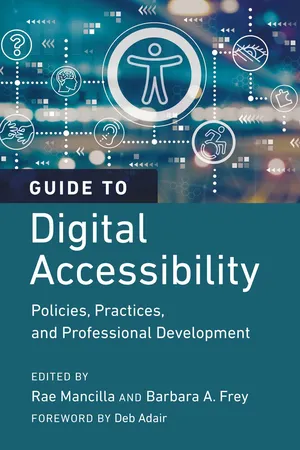
Guide to Digital Accessibility
Policies, Practices, and Professional Development
- 312 pages
- English
- ePUB (mobile friendly)
- Available on iOS & Android
Guide to Digital Accessibility
Policies, Practices, and Professional Development
About this book
Co-published with Quality Matters
"The collective depth and tenure of experience of the authors in advancing accessibility practice is trulyexceptional. In practical terms, the organization of the book makes clear the work to be done and the imperative for doing it. It is about understanding the context for accessibility and making change happen in policy, practice, and professional development. At QM, our position is straightforward. A course is not quality unless it is accessible for all. This book represents the many ways our community is walking that talk. -- from the Foreword by Deb Adair, Executive Director of Quality Matters
Approximately 8.5% of the general population of the United States has a disability affecting their computer and Internet use, which translates to over 28 million people in the U.S. alone whose disability impacts their access to digital content. Recent data indicates that around 19% of undergraduate students have a disability, yielding consequential implications for institutions of higher education. Regardless ofdisabilities or environmental constraints, educators have a legal and ethical responsibility to create online learning experiences that are accessible and usable by all learners.
Addressed to higher education administrators, instructional designers, faculty developers, and faculty, this edited volume showcases the experiences and practices of Quality Matters institutions around the core tenets of digital accessibility, offering examples of policy, processes, practices, tools, and professional development. The contributors represent a carefully curated body of institution types and classifications to ensure that all readers can transfer concepts into the contexts of their respective institutions.
The book situates the digital accessibility movement within the context of major federal legislation, such as the Americans with Disabilties Act of 1990. It traces the evolution of Web Content Accessibility Guidelines for online course design and professional development based on the Quality Matters framework.
Subsequent chapters describe the evolution of accessibility policy development as a driver of organizational culture, as well as a continuum of course design practices that can be implemented to proactively develop inclusive instructional materials.
The Guide concludes by identifying a myriad of professional development formats for fostering accessibility knowledge and skill acquisition, including asynchronous workshops, micro credentials, and train-the-trainer models, sharing evaluation protocols that foster continuous improvement.
Written for practitioners by practitioners, this book addresses vital compliance issues and maps a range of proven practices that will enrich the learning experience of all learners in digital environments.
Frequently asked questions
- Essential is ideal for learners and professionals who enjoy exploring a wide range of subjects. Access the Essential Library with 800,000+ trusted titles and best-sellers across business, personal growth, and the humanities. Includes unlimited reading time and Standard Read Aloud voice.
- Complete: Perfect for advanced learners and researchers needing full, unrestricted access. Unlock 1.4M+ books across hundreds of subjects, including academic and specialized titles. The Complete Plan also includes advanced features like Premium Read Aloud and Research Assistant.
Please note we cannot support devices running on iOS 13 and Android 7 or earlier. Learn more about using the app.
Information
Table of contents
- Cover
- Advance Praise for Guide to Digital Accessibility
- Half-title Page
- Title Page
- Copyright
- Dedication
- Contents
- List of Figures
- List of Tables
- List of QR Codes
- Foreword
- Preface
- Acknowledgments
- Part One: Digital Accessibility Background and Historical Perspectives
- Part Two: Digital Accessibility Policy
- Part Three: Digital Accessibility Course Development Practices and Tools
- Part Four: Digital Accessibility Professional Development
- List of Common Abbreviations
- Editors and Contributors
- Index
- Also available from Stylus
- Backcover